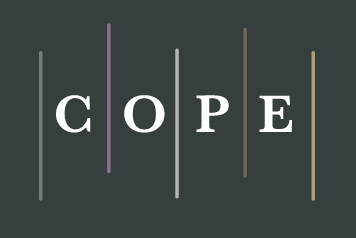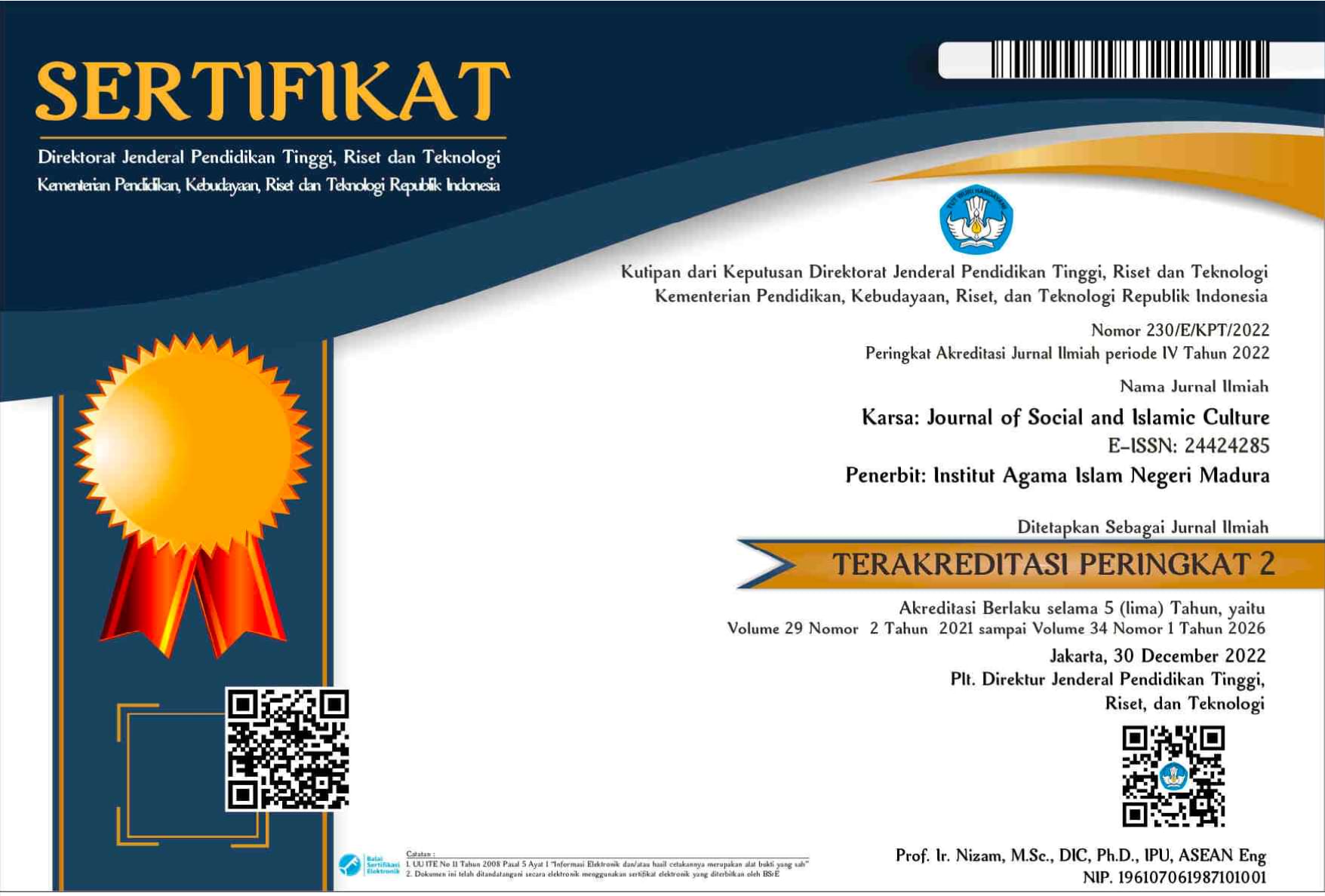Religious Harmony Construct Amid A Plural Community in East Java
 Abstract views: 675
,
Abstract views: 675
,
 PDF downloads: 355
PDF downloads: 355
Abstract
This study examined the harmonization of five religions (Islam, Catholicism, Protestantism, Hinduism, and Buddhism) that are adhered to by the people of Mojorejo Village, Batu, East Java. This village has an important role, as it becomes the first area in Batu, East Java – that implement and develop the concept of religious pluralism and harmonization in one village area thus it has been awarded as “A Village that is Aware of Religious Harmony” from the government of Batu. Therefore, this study aimed to understand the constructs of religious harmony that have been successfully established in Mojorejo Village, Batu, East Java. The theory underlying this study is Nurcholis Madjid’s theory of humanist pluralism. This study used a qualitative approach to produce descriptive data in the form of oral, written, and observable behavior. Through three data collection methods (observation, in-depth interview, a study of documents), this study concludes that the religious harmony construct of the Mojorejo Village community is established from a pattern of accustoming mutual respect among villagers which is carried out both naturally and sustainably. This continuity manifests through cooperation in three ways: religious, social, and cultural cooperation so that it can lead to the emerge of perspectives, ideas, and a social environment capable of maintaining and preserving religious plurality in harmony. Therefore, the application of religious harmony in Mojorejo Village, Batu, East Java can be used as an alternative solution for other areas in locating and facilitating religious plurality so that it remains harmonious amid a pluralistic community.
Downloads
References
Afrian, U. “FKUB Launching Desa Sadar Kerukunan Beragama.” radarmalang.id, 2019. https://radarmalang.id/fkub-launchingdesa-sadar-kerukunanberagama/.
Ali, Mukti, Abdurrahman, Burhanuddin Daya, and Djam’annuri. Agama Dan Masyarakat: 70 Tahun H.A. Mukti Ali. Yogyakarta: IAIN Sunan Kalijaga Press, 1993.
Aryani, Ni Luh. “Implementation of Communication Ethics in Building Social Harmony.” International Journal of Social Sciences and Humanities 2, no. 1 (2018): 147–56. https://doi.org/10.29332/ ijssh.v2n1.105.
Bakar, Abu. “Konsep Toleransi Dan Kebebasan Beragama.” Toleransi: Media Komunikasi Umat Bergama 7, no. 2 (2015): 123–31.
Batu, Dinas Kependudukan dan Catatan Sipil Kota. “Jumlah Penduduk Menurut Kecamatan Dan Agama Yang Dianut Di Kota Batu, 2017.” batukota.bps.go.id, 2019. https://batukota.bps.go.id/static table/2018/12/12/315/jumlah-penduduk-menurut-kecamatandan-agama-yang-dianut-di-kota-batu-2017.html.
Casram. “Membangun Sikap Toleransi Beragama.” Wawasan: Jurnal Ilmiah Agama Dan Sosial Budaya 1, no. 2 (2016): 187–98.
Dinata, Muhamad Ridho. “Konsep Toleransi Beragama Dalam Tafsir Al-Qur’an Tematik Karya Tim Departemen Agama Republik Indonesia.” Esensia 13, no. 1 (2012): 85–108.
Fidiyani, R. “Kerukunan Umat Beragama Di Indonesia ( Belajar Keharomonisan Dan Toleransi Umat Beragama Di Desa Cikakak, Kec. Wangon, Kab. Banyumas).” Jurnal Dinamika Hukum 13, no. 3 (2013): 468–82.
Hafiar, Hanny. “Religious Activities of The Scavenger at The Landfill in West Java Region.” Karsa: Journal of Social and Islamic Culture 27, no. 1 (2019): 149–70. https://doi.org/10.19105/karsa. v27i1.2145.
Halim, Abdul, and HM Pahrudin. “The Role of Local Wisdom as Religious Conflict Resolution in Jambi Indonesia.” Walisongo: Jurnal Penelitian Sosial Keagamaan 27, no. 2 (2019): 353–74. https://doi.org/10.21580/ws.27.2.4358.
Ismail, Roni. “Konsep Toleransi Dalam Psikologi Agama (Tinjauan Kematangan Beragama).” Religi 8, no. 1 (2012): 1–12. https://doi. org/10.14421/rejusta.2012.%25x.
Jazadi, Iwan. “The Concerns, Roots, and Challenges of Islamic Culture in Sumbawa and Their Implications for Implementing Halal Tourism.” Karsa: Journal of Social and Islamic Culture 27, no. 1 (2019): 52–74. https://doi.org/10.19105/ karsa.v27i1.2299.
Kemdikbud RI, BPPB. “Arti Kata Harmonisasi.” KBBI Daring, 2020. https://kbbi.kemdikbud.go.id/entri/harmonisasi.
Madjid, Nurcholish. Pluralitas Agama: Kerukunan Dalam Keragaman. Jakarta: Kompas, 2001.
Makmur, Testiani, and Wenny Dastina. “Cultivating Local Wisdom in Character Education: Lessons from Family Education Values of Indonesian Traditional Ceremony.” Walisongo: Jurnal Penelitian Sosial Keagamaan 26, no. 2 (2018): 417–44. https://doi.org/10. 21580/ws.26.2.2753.
Mojorejo, Arsip Desa. “Jumlah Penduduk Desa Mojorejo dan Tempat Ibadah Yang Dimiliki.” Batu, 2020.
Munawaroh, Lathifah. “Harmonisasi Antar Umat Beragama Melalui Pernikahan Beda Agama.” Fikrah: Jurnal Ilmu Aqidah Dan Studi Keagamaan 5, no. 1 (2017): 197–218. https://doi.org/10.21043/ fikrah.v5i1.2307.
Muslih, M. “Empowering Teacher of Religious Education in Multicultural Society.” Walisongo: Jurnal Penelitian Sosial Keagamaan 25, no. 1 (2017): 173. https://doi.org/10.21580/ws.25. 1.1213.
Pamungkas, Cahyo. “Toleransi Beragama Dalam Praktik Sosial: Studi Kasus Hubungan Mayoritas Dan Minoritas Agama Di Kabupaten Buleleng.” Epistemé: Jurnal Pengembangan Ilmu Keislaman 9, no. 2 (2014): 285–316.
Qowaid. “Gejala Intoleransi Beragama Di Kalangan Peserta Didik Dan Upaya Penanggulangannya Melalui Pendidikan Agama Islam Di Sekolah.” Dialog: Jurnal Penelitian Dan Kajian Keagamaan 36, no. 1 (2013): 71–86.
Rifa’i, Andi Arif. “Religious and Tolerant Attitudes of University Students : A Comparative Study.” Walisongo: Jurnal Penelitian Sosial Keagamaan 27, no. 1 (2019): 125–48. https://doi.org/10. 21580/ws.27.1.3872.
Rokhmad, Abu. “The Role of Inter-Religious Harmony Forum in Maintaining The Harmony of Religious Life in Plural Society.” The Social Sciences 11, no. 21 (2016): 5052–59. https://doi.org/ 10.3923/sscience.2016.5052.5059.
Santiko, Hariani. “Toleransi Beragama Dan Karakter Bangsa: Perspektif Arkeologi.” Sejarah Dan Budaya 7, no. 1 (2013): 1–8.
Soares, Francisco, and I Ketut Sudarsana. “Religious Harmony Among Senior High School Students Multicultural Education Case Study in the Cova-Lima District of East Timor.” Vidyottama Sanatana: International Journal of Hindu Science and Religious Studies 2, no. 1 (2018): 154–62. https://doi.org/10.25078/ijhsrs.v2i1.522.
Soekanto, Soerjono. Sosiologi Suatu Pengantar. Jakarta: PT Grafindo Persada, 2010.
Suryana, Toto. “Konsep Dan Aktualisasi Kerukunan Antar Umat Beragama.” Pendidikan Agama Islam -Ta’lim 9, no. 2 (2011): 127–36.
Wijaya, S. H. B., Mursito, & Anshori, M. “Media Massa Dan Intoleransi Beragama (Studi Kasus Tentang Wacana Intoleransi Beragama Pada Surat Kabar Lokal di Kota Surakarta Tahun 2012).” Jurnal Komunikasi Massa 6, no. 2 (2013): 175–88.
The journal operates an Open Access policy under a Creative Commons Non-Commercial Share-Alike license. Authors who publish with this journal agree to the following terms:
- Authors retain copyright and grant the journal right of first publication with the work simultaneously licensed under a Creative Commons Attribution License that allows others to share the work with an acknowledgement of the work's authorship and initial publication in this journal.
- Authors are able to enter into separate, additional contractual arrangements for the non-exclusive distribution of the journal's published version of the work (e.g., post it to an institutional repository or publish it in a book), with an acknowledgement of its initial publication in this journal.
- Authors are permitted and encouraged to post their work online (e.g., in institutional repositories or on their website) prior to and during the submission process, as it can lead to productive exchanges, as well as earlier and greater citation of published work.





















